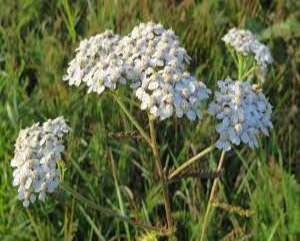Description: Yarrow, scientifically known as Achillea millefolium, is a perennial herbaceous plant belonging to the Asteraceae family. Widely distributed across North America, Europe, and Asia, Yarrow is recognized for its feathery, finely divided leaves and clusters of small, tightly packed flowers. It is valued for its ornamental qualities, medicinal uses, and ecological contributions.
Habitat and Distribution: Common Yarrow is adaptable to a variety of habitats and is commonly found in meadows, pastures, roadsides, and disturbed areas. It prefers well-drained soils and is often encountered in both sunny and partially shaded locations. Yarrow is a versatile plant that has naturalized in many regions.
Physical Features:
- Leaves: The leaves of Yarrow are highly dissected, giving them a feathery appearance. They are arranged alternately along the stem and emit a distinctive fragrance when crushed.
- Flowers: Yarrow produces flat-topped clusters of small flowers with a range of colors, including white, pink, and yellow. The flowers are composed of tiny florets and are attractive to pollinators.
Ecological Significance:
Yarrow plays several ecological roles:
- Pollinator Attraction: The flowers of Yarrow attract a variety of pollinators, including bees, butterflies, and hoverflies, contributing to local biodiversity.
- Soil Improvement: Yarrow's deep roots help improve soil structure and nutrient cycling.
Cultural Uses:
- Ornamental Plant: Yarrow is cultivated for its attractive flowers and fern-like foliage, making it a popular choice in gardens and landscapes.
- Medicinal Herb: Yarrow has a history of traditional medicinal use, with various parts of the plant believed to have healing properties. It is often used in herbal remedies.
Concerns and Challenges:
- Invasive Potential: While valued in gardens, Yarrow can spread rapidly in certain conditions and become invasive in natural ecosystems.
Control and Management:
Cultural Practices:
- Regular Pruning: Pruning Yarrow after flowering can help control its height and prevent self-seeding.
- Dividing Clumps: Periodically dividing clumps of Yarrow can rejuvenate the plant and reduce its spread.
Mechanical Control:
- Hand Pulling: Hand pulling is effective for small infestations. Removing the entire plant, including the roots, is essential to prevent regrowth.
Chemical Control:
- Herbicides: Non-selective herbicides can be used for targeted spot treatments. Carefully follow application instructions to avoid harm to desirable plants.
Preventing Spread:
- Containment Measures: Installing barriers, such as edging or root barriers, can help contain the spread of Yarrow by restricting the growth of its rhizomes.
- Monitoring and Early Intervention: Regularly monitoring Yarrow in gardens and natural areas allows for early detection. Prompt removal or control measures can prevent its spread.
- Choosing Cultivars Wisely: Selecting non-invasive cultivars or hybrids of Yarrow can be a proactive measure to enjoy its ornamental qualities without the risk of aggressive spreading.
In conclusion, Yarrow is a versatile plant with ornamental and ecological value. While its rapid spread can pose challenges, proper management practices, including regular pruning, division, and, if necessary, controlled use of herbicides, can help strike a balance between enjoying Yarrow in gardens and preventing its invasive potential in natural ecosystems.



